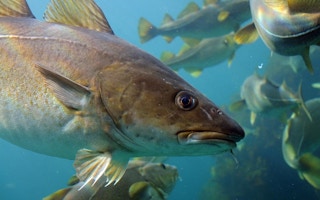The Atlantic halibut is about to go where no Atlantic halibut has gone before – into the Pacific. And it could meet the Alaska pollock coming in the other direction.
Just as marine commerce could soon exploit the opening of the fabled north-west or north-east passages between the two great oceans, so could at least 80 species of fish.
Mary Wisz, an ecologist now with the Danish DHI group, but formerly at the Arctic Research Centre of Aarhus University in Denmark, reports with colleagues in Nature Climate Change that as sea temperatures increase, and food sources begin to flourish at the highest latitudes, shoals of fish from the Atlantic could reach the Pacific along once almost impassable seaways north of Arctic Canada and Siberia.
Northerly species
The last such large-scale transfer was nearly three million years ago, with the opening of the Bering Strait. But climate conditions that were once harsh have begun to open migration opportunities for the northerly species in both oceans, the researchers say.
Such changes have happened before. Since the opening of the Suez Canal in 1869, the Mediterranean has been invaded by 55 Red Sea species, with a “drastic impact” on commercial fisheries.
Fish are already moving north in response to climate change, and Dr Wisz and her colleagues modelled what would happen to 515 species of fish under predicted conditions of global warming later this century.
By 2050, the scientists believe, trans-Arctic traffic will accelerate, and by 2100, 41 Atlantic species − among them cod and herring − could reach the Pacific, while 44 species could get into the Atlantic.
They warn: “This exchange of fish species may trigger changes in the North Atlantic and the North Pacific, with ecological and economic consequences to ecosystems that at present contribute 39 per cent to global marine fish landings.”
The Danish-led team was essentially modelling temperature, currents and spawning strategies to see which species were most likely to find new grounds. But changes to marine chemistry also threaten the balance of power in the oceans.
“
This exchange of fish species may trigger changes in the North Atlantic and the North Pacific, with ecological and economic consequences to ecosystems that at present contribute 39 per cent to global marine fish landings.
Dr Mary Wisz and her colleagues at the Arctic Research Centre of Aarhus University in Denmark
The seas are predicted to become more acidic as more carbon dioxide gets into the atmosphere, and this change in water chemistry is likely to affect not just fish and shellfish but also entire communities of creatures.
Scientists have tested the fauna that foul ships’ hulls. These are the tiny barnacles and squirts that attach themselves to hard surfaces wherever they can in the oceans.
Lloyd Peck, a biologist with the British Antarctic Survey, and colleagues report in Global Change Biology that they tested creatures from a lagoon off the Algarve in Portugal, in aquarium tanks.
One set of tanks was filled with normal sea water; in the other set, the sea water was set at levels of acidity predicted to be normal within the next 50 years. Within 100 days, in the more acid tanks, the make-up of the community that colonised the hard surfaces had begun to change.
Worms with hard shells in the more acidic tanks were reduced to a fifth of their normal levels, but sponges and sea squirts multiplied twofold and even fourfold.
“Our experiment shows the response of one biofouling community to a very rapid change in acidity,” said Professor Peck. “What’s interesting is that the increased acidity at the levels we studied destroys not only the building blocks in the outer shell of the worms itself, but the binding that holds it together.
“Many individuals perish, but we also showed their larvae and juveniles are also unable to establish and create their hard exoskeletons.”
Altered behaviour
Climate change could also alter the behaviour of the green sea turtle, Chelonia mydas, according to an international team led by Professor Kyle Van Houtan, of the Nicholas School of the Environment and Earth Sciences at Duke University, US.
The researchers studied six years of turtle observations off Oahu, Hawaii, and 24 years of satellite data for sea surface temperatures in regions that are home to 11 populations of the turtle.
They report in Biology Letters that they know why the turtles crawl up onto the beach to bask. Not all populations bask, but the ones that do tend to sprawl in the sand do so to regulate body temperatures, and were least likely to bask when local winter sea temperatures stayed above 23°C. When the seas stayed warm, the turtles stayed in the water.
Given the predicted ocean temperature rises over the next century, the scientists calculate that green turtles may stop basking altogether by 2100.

















